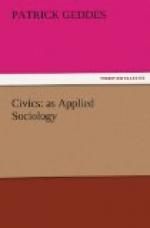With the poor living under bad conditions in crowded homes the net increase is diminished. To those of us who are hopeful of improvement by eugenics it is pleasing to note that Mr. Booth—somewhat unlike Mr. Kidd in his well-known “Social Evolution”—is optimistic in his conclusion that “on the whole it may fairly be expected that concurrently with a rising standard of health we may see a fall in birth-rate as well as death-rate, and thus have no cause to fear, as the result of better sanitation, that the largest natural increase in population will ever be contributed by the lowest class.” So the heritage of the city may grow not only in quantity but also in quality.
From PROFESSOR W.I. THOMAS
(Professor in the University of Chicago, U.S.A.)
From the standpoint of its applicability to new countries like America, Professor Geddes’ programme is inadequate because of its failure to recognise that a city under these conditions is formed by a rapid and contemporaneous movement of population, and not by the lapse of time. [Page: 136] The first permanent white settler came to Chicago precisely one hundred years ago, and the city has a population at present of about two and a quarter millions. It is here not a question of slow historic development but of the rapid drifting towards a certain point, of a population from all quarters of the globe, and the ethnological standpoint therefore becomes of more importance than the historical.
PROFESSOR GEDDES’ reply
I am sincerely glad to be able to express myself in substantial agreement with the majority of my critics, only asking them in turn to recognise that this is but the first half of my subject—an outline of civics as in the first place a matter of science, a geographic and historic survey of past conditions, a corresponding census of present ones—here discussed and insisted on as affording the needful base for their demands upon civics as an art, that of effective social service.
In this respect various critics have in fact anticipated large elements of this future portion of my paper, so that in general views, at least, critics and writer are not so far apart as would appear were the preceding pages submitted as a comprehensive outline of the subject, instead of as its scientific introduction merely.
Of criticisms strictly applicable to this paper as it stands, there are really very few. I am confident that the chairman must be quite alone in too modestly applying to his great work that description of London itself, with which the paper (Section A, pp. 104-107) opens, since his volumes offer really our first effective clue to the labyrinth, and his method of intensive and specialised regional survey, the intensest searchlight yet brought to bear upon it.




